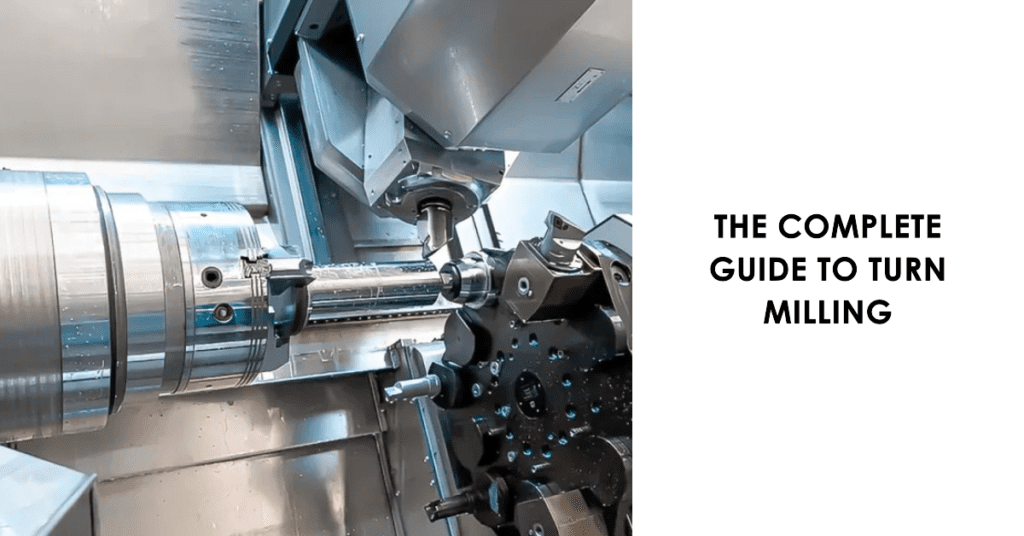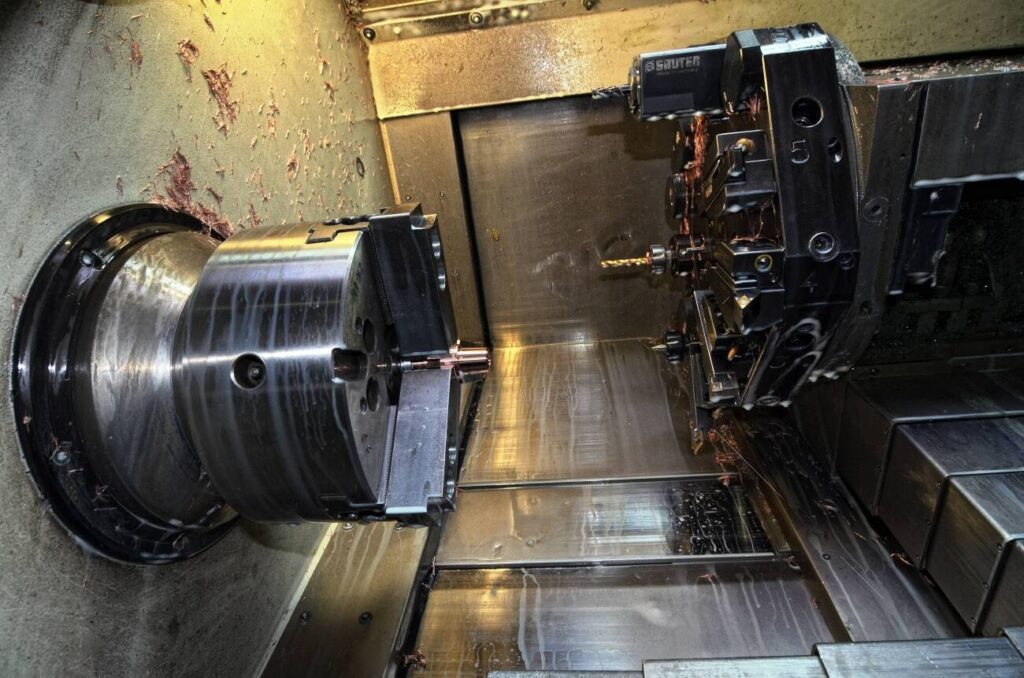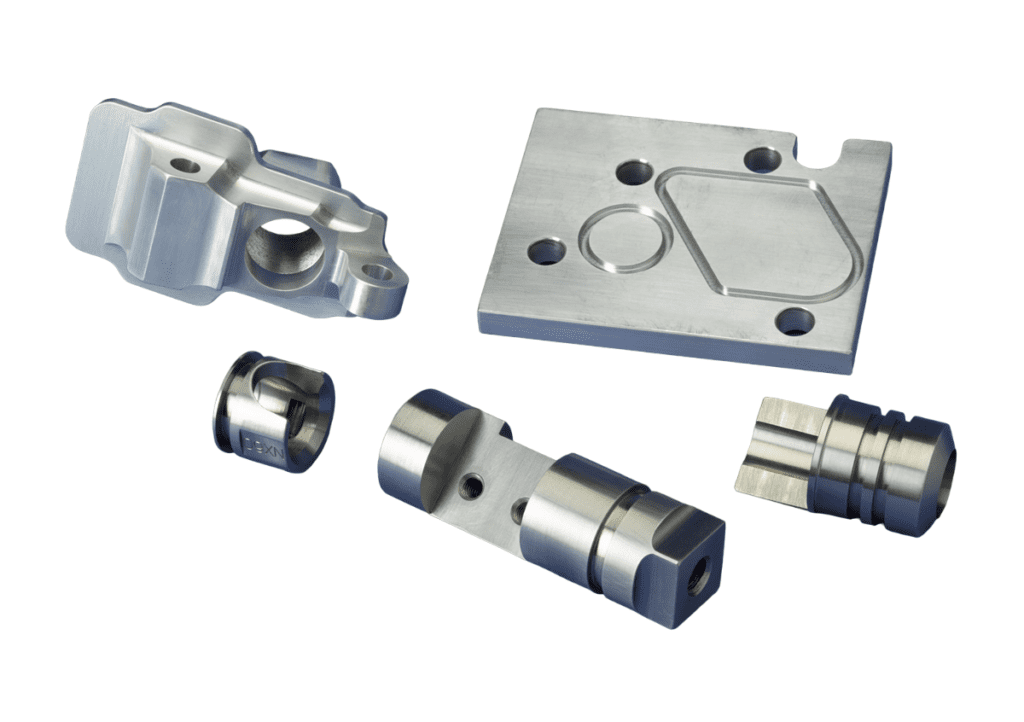
Precision machining has witnessed significant advancements over the years, making it possible to produce intricate and high-quality components efficiently. Among these advancements, turn milling stands out, a technique that fuses the principles of turning and milling, providing manufacturers with a potent tool to enhance productivity, precision, and profitability.
This guide offers a comprehensive exploration into turn milling, presenting a clear understanding of its history, applications, advantages, and mechanisms. Delve into the world of turn milling and discover why it’s hailed as a revolution in CNC machining.
The Fundamentals: What is Turn Milling?

CNC turn milling tap
Turn milling is an advanced machining method that ingeniously combines two primary machining processes: turning and milling. This union creates a dynamic approach to crafting complex components with enhanced efficiency and precision.
Traditional manufacturing relied heavily on manual operations where turning and milling were distinct processes, each requiring its machine setup. Over time, with the emergence and dominance of Computer Numerical Control (CNC) technology, machinists began to recognize the potential of combining these operations. This gave birth to turn-milling, which capitalizes on CNC’s ability to control multiple tool paths and operations simultaneously.
Related Resource:
The Dual Operation Explained
Turn milling doesn’t merely entail alternating between turning and milling operations on a single machine. Instead, it involves simultaneous or concurrent execution of these operations, offering unique advantages.
- Turning: This involves rotating the workpiece while the cutting tool moves in a linear trajectory. It’s primarily used to create cylindrical or round shapes.
- Milling: Here, the workpiece remains stationary (or moves linearly), while the cutting tool rotates. This process is best suited for creating intricate designs, grooves, and slots.
Table 1: Differences between Turning and Milling
| Criteria | Turning | Milling |
|---|---|---|
| Movement | Workpiece rotates, the tool moves linearly | The tool rotates, the workpiece is stationary/linear |
| Best For | Cylindrical shapes | Complex designs, grooves |
| Tool Type | Single-point cutting tool | Multi-point cutting tool |
Tolerances in Turn Milling
Achieving precise tolerances is paramount in machining. With turn milling, manufacturers can attain tighter tolerances due to the process’s inherent precision.
Table 2: Achievable tolerances with turn-milling
| Component | Typical Tolerance | Achievable with Turn Milling |
|---|---|---|
| External Diameter | ± 0.005 in | ± 0.002 in |
| Internal Diameter | ± 0.005 in | ± 0.002 in |
| Groove Width | ± 0.004 in | ± 0.0015 in |
| Surface Finish | Ra 3.2 | Ra 1.6 |
Historical Overview of Turn Milling
The journey of turn milling is as intriguing as its application. From the earliest methods of manual machining to the sophisticated CNC machinery today, turn milling has evolved, becoming a testament to human ingenuity and the relentless quest for manufacturing excellence.
1. The Age of Manual Machining
Before the onset of automated processes, manual machining dominated the manufacturing landscape. Artisans relied on lathes for turning and milling machines for milling, each process being distinctly separate.
2. Transition to Semi-Automated Processes
With the dawn of the industrial revolution, manufacturers sought ways to enhance productivity. This led to the birth of semi-automated machinery, where certain processes were automated while still requiring manual oversight.
Table 3: Manual vs. Semi-Automated Machining
| Criteria | Manual Machining | Semi-Automated Machining |
|---|---|---|
| Speed | Slow | Moderately Fast |
| Precision | Moderate | High |
| Labor Intensity | High | Moderate |
| Cost | Lower Initial Cost | Higher Initial Cost |
3. The Advent of CNC and the Birth of Turn Milling
The true revolution in turn milling was catalyzed by the rise of CNC technology. With CNC’s ability to control multiple operations simultaneously, turn milling transformed from a concept to reality. The 1980s and 1990s saw significant adoption of turn milling, as manufacturers recognized its unmatched potential.
4. Modern-Day Turn Milling and its Dominance
Today, turn milling isn’t just an option but a standard in many industries. With advancements in software, tooling, and machinery, turn milling has become more accessible, efficient, and precise.
What Are the Advantages of Turn Milling?
Turn milling’s rise to prominence isn’t coincidental. Its array of benefits places it ahead of traditional machining methods, making it a favorite among modern manufacturers.
1. Enhanced Precision and Tolerance
One of the primary advantages of turn milling is its unparalleled precision. Combining turning and milling operations means fewer setups, reducing the chances of errors and ensuring tighter tolerances.
Table 4: Tolerance comparison
| Operation | Traditional Machining Tolerance | Turn Milling Tolerance |
|---|---|---|
| External Diameter | ± 0.005 in | ± 0.002 in |
| Groove Depth | ± 0.004 in | ± 0.0015 in |
| Surface Finish | Ra 3.2 | Ra 1.6 |
2. Time and Cost Efficiency
Turn milling eliminates the need to transfer parts between different machines, streamlining the production process and slashing lead times. This time-saving translates directly to cost reductions, making turn milling both efficient and economical.
3. Flexibility in Design and Application
Turn milling, with its combined approach, allows for the production of complex parts that might be challenging or impossible with traditional methods. This gives designers greater freedom and versatility in their creations.
4. Reduction in Waste
With enhanced precision and fewer setups, there’s a notable reduction in material waste. This not only makes turn milling an economical choice but an environmentally friendly one too.
Overall, turn milling’s array of advantages, from precision to efficiency and design flexibility, make it a pivotal process in modern manufacturing. Embracing this method translates to enhanced product quality, reduced costs, and a competitive edge in the market. As industries continue to evolve, turn milling stands as a beacon of innovation and excellence.
Try Prolean Now!
Key Applications of Turn Milling

Parts created with CNC turn milling
Turn milling has transformed the way industries view the production of intricate parts. Its versatility, coupled with unmatched precision, has made it a prime choice across diverse sectors. Let’s dive into some of the key applications that have benefited immensely from the advent of turn milling.
1. Aerospace and Defense
The aerospace and defense industries prioritize accuracy and durability above all else. Turn milling’s ability to manufacture complex components with tight tolerances makes it invaluable in this sector.
Table 5: Aerospace Components and Their Tolerances
| Component | Traditional Tolerance | Turn Milling Tolerance |
|---|---|---|
| Turbine Blades | ± 0.006 in | ± 0.002 in |
| Landing Gear Components | ± 0.005 in | ± 0.002 in |
| Engine Casings | ± 0.007 in | ± 0.003 in |
2. Medical Equipment and Devices
In the realm of medical devices, even the minutest discrepancy can have grave consequences. Turn milling ensures the production of implants, surgical tools, and diagnostic devices with the highest precision.
3. Automotive Industry
From engine components to intricate transmission parts, turn milling aids in the production of a myriad of automotive parts that demand a balance of speed and precision.
Steps-wise description of manufacturing a transmission gear:
- Design & Blueprint: The initial design of the gear, considering dimensions, teeth count, and desired tolerances.
- Material Selection: Choosing the right metal alloy, ensures durability and wear resistance.
- Turning Process: The primary shape of the gear is attained using turning.
- Milling Process: Precision cuts are made to achieve the gear teeth and other intricate details.
- Heat Treatment: To enhance the durability of the gear.
- Quality Check: Ensuring all dimensions align perfectly with the design specifications.
- Assembly: If the gear is part of a more extensive system, it’s assembled accordingly.
4. Electronics and Semiconductors
Turn milling is paramount in achieving the microscopic precision required in semiconductor production and intricate electronic components.
Table 6: Tolerances Comparison for Semiconductor Components
| Component | Traditional Tolerance | Turn Milling Tolerance |
|---|---|---|
| Chipsets | ± 0.003 in | ± 0.001 in |
| Connectors | ± 0.002 in | ± 0.0008 in |
| PCB Mounts | ± 0.004 in | ± 0.0015 in |
5. Energy Sector
Whether it’s the traditional oil and gas sector or the evolving renewable energy market, turn milling plays a pivotal role in producing durable and efficient components, from turbine blades for wind energy to drilling components for oil exploration.
Turn milling has applications in various industries, including the energy sector. For wind energy, turbine blades are critical to harnessing wind efficiently. In the oil and gas sector, drill bits ensure precise drilling for exploration, while in the solar industry, mounting structures hold solar panels securely. Turn milling has made it possible to produce these components with enhanced precision, efficiency, and cost-effectiveness.
Modern Innovations in Turn Milling
Turn milling, like many machining processes, has not been static. Modern technological advancements have continued to push the boundaries of what’s achievable with this technique. These innovations are not just improving efficiencies but also expanding the range of possible applications.
1. Integration with Computer-Aided Design (CAD)
The advent of CAD technology has transformed the design process for turn milling operations. By simulating the entire milling process digitally, engineers can anticipate potential issues and optimize designs even before actual machining begins.
2. Automated Tool Changing Systems
Automatic tool changers have revolutionized turn milling. By minimizing manual interventions, these systems have greatly increased productivity and reduced the margin of error. It reduce the time taken for tool changing from 3-5 minutes to 5-10 seconds. This system greatly increases productivity and reduces the margin of error by minimizing manual interventions. It also improves precision consistency and efficiency.
3. High-Speed Turn Milling
With advancements in machine construction and spindle technology, turn milling operations can now be executed at higher speeds without compromising on precision. This has dramatically reduced production times and improved throughput.
4. Incorporation of Artificial Intelligence (AI) and Machine Learning
Modern turn milling machines are increasingly harnessing the power of AI and machine learning. These technologies enable the equipment to learn from every operation, optimizing the process for better results over time.
5. Environmentally Friendly Machining
Sustainability has become paramount, and the turn milling sector is no exception. Modern machines are designed to minimize waste, use lesser energy, and have features that enable the recycling of coolants and lubricants.
Turn milling machines are designed to be environmentally friendly, with features such as energy efficiency, coolant recycling, and low emission motors. These machines aim to minimize waste and reduce power consumption, making the turn milling process more sustainable. As the industry looks to the future, sustainability will likely continue to be a focus in the development of turn milling technology.
Challenges and Solutions in Turn Milling
Turn milling, while offering various advantages and applications, is not without its challenges. However, with modern technological advancements and skilled approaches, solutions to these challenges are continually being developed.
1. Material Deformation
Challenge: When working with softer metals or thin-walled components, turn milling can sometimes cause deformation, leading to inaccuracies in the final product.
Solution: By optimizing the tool path and using supportive jigs or fixtures, deformation can be minimized. It’s also beneficial to select the right cutting tool materials and geometries for specific workpieces.
2. Tool Wear and Breakage
Challenge: Constant engagement of the tool with the workpiece in turn milling can lead to accelerated tool wear and, in some cases, tool breakage.
Solution: Regular tool inspections, the use of high-quality tool materials like tungsten carbide, and proper cooling can drastically reduce wear and prevent breakages.
Table 7: Tips to Prevent Tool Wear
| Tips | Description |
|---|---|
| Proper Cooling | Ensure a steady supply of coolant to reduce heat. |
| Quality Tool Materials | Invest in durable tools made from robust materials. |
| Regular Inspections | Check tools frequently for signs of wear or damage. |
3. Surface Finish Concerns
Challenge: Achieving a desirable surface finish can sometimes be tricky, especially when working with tough metals or when the tool isn’t optimized.
Solution: Adjusting the feed rate, ensuring the tool’s sharpness, and optimizing the machine’s speed can lead to better surface finishes.
To achieve a desirable surface finish in turn milling, it’s essential to inspect the tool for sharpness and damage, optimize the feed rate and machine speed, apply proper cooling, and use post-processing techniques such as polishing.
Turn Milling vs. Conventional Machining
Comparing turn milling with conventional machining methods provides insights into why one might be chosen over the other for specific applications.
1. Efficiency
Turn milling often offers higher efficiency than conventional machining, especially for complex components, as it can perform multiple operations without having to re-fixture the workpiece.
2. Versatility
Turn milling is a machining technique that combines turning and milling operations to craft complex components with enhanced efficiency and precision. It’s a potent tool that provides manufacturers with unmatched potential to improve productivity, precision, and profitability. Turn milling is well-suited for complex geometries, a wide range of materials, and multi-operation requirements, making it a more versatile option than conventional machining.
3. Surface Finish
As previously discussed, turn milling can sometimes struggle with surface finishes, especially when not optimized. However, with the correct settings, it can rival or even surpass conventional machining in this aspect.
Turn milling typically achieves tolerances of 10-15 microns, while conventional machining can achieve tolerances of 5-10 microns.
4. Cost-effectiveness
For large batch productions or simple parts, conventional machining might prove more cost-effective. However, for intricate designs and multi-operation requirements, turn milling often comes out ahead due to reduced setup times and increased efficiency.
Summing Up
Turn milling represents a significant evolution in the machining world. By integrating the capabilities of turning and milling into a single process, it provides a multifaceted approach to creating intricate parts with high precision. The technology, although not without its challenges, offers an array of solutions to mitigate common issues. Its comparison with conventional machining shows that while the latter has its place in the industry, turn milling offers unique advantages, especially for complex projects. As we navigate the future of manufacturing and production, the versatility, efficiency, and precision of turn milling will undeniably play a pivotal role.
In your quest for unmatched precision and efficiency in turn milling, Prolean’s CNC Turning Milling Services offers unparalleled expertise and cutting-edge solutions. Entrust us with your projects, and witness the epitome of excellence in CNC machining.
Read more: CNC Milling: Definition, Process, Benefits & Applications
FAQs
What materials are best suited for turn milling?
Turn milling is versatile and can handle a wide range of materials, including metals, plastics, and more. The key is to choose the right tools and settings for each specific material.
How does turn milling enhance production efficiency?
Turn milling enhances efficiency by allowing multiple machining operations without the need to re-fixture or move the workpiece between machines. This not only saves time but also improves the accuracy of the final product.
Are there any environmental concerns with turn milling?
Like all machining processes, turn milling generates waste in the form of metal shavings or chips. However, with modern machinery and techniques, this waste is often collected, recycled, or reused. Additionally, with proper cooling and lubrication, wear and tear on tools can be minimized, reducing environmental impact.
Is turn milling cost-effective for small batch production?
While turn milling is highly efficient, its cost-effectiveness for small batch production depends on the complexity of the parts. For simple parts, conventional methods might be more economical. However, for intricate designs requiring multiple operations, turn milling can prove cost-effective even for smaller batches




0 Comments